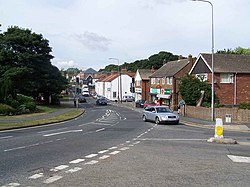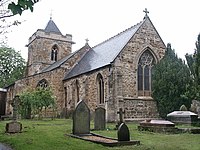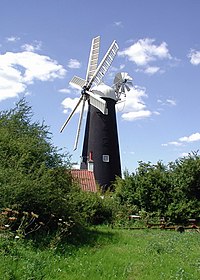Waltham, Lincolnshire
| Waltham | |
| Lincolnshire | |
|---|---|
 Waltham Village | |
| Location | |
| Grid reference: | TA259038 |
| Location: | 53°30’59"N, 0°6’7"W |
| Data | |
| Population: | 6,420 (2001) |
| Post town: | Grimsby |
| Postcode: | DN37 |
| Local Government | |
| Council: | North East Lincolnshire |
| Parliamentary constituency: |
Cleethorpes |
Waltham is a village in Lincolnshire. It is four miles southwest of Grimsby and to the villages of Scartho, Brigsley, Barnoldby-le-Beck, and Bradley. Less than two miles to the northeast is the village of New Waltham. According to the 2001 Census, Waltham had a population of 6,420.
History

There was a substantial Anglo-Saxon settlement on the site of the first village although artefacts show earlier Roman occupation. The name of Waltham name is of Old English origin, apparently in this case from weald referring to woodland.
Elizabeth Shaw, a centenarian who lived to age 117, was born 22 April 1683 at Waltham. A life portrait of her by R. Sheardown was published in 1800.[1]
Sights about the village

Waltham's landmarks include Waltham Windmill, which is used as the symbol for the village's Infant and Junior schools. The windmill was originally built in 1666,[2] but was blown down several times. It was last re-built in 1873.[3]
The village has three public houses, The Kings Head, the Tilted Barrel and the Tea Gardens. A branch of the Royal British Legion is also based in Waltham.
Nearby is the former Second World War bomber airfield RAF Grimsby,[4] which was originally Grimsby Municipal Airport. After the start of the Second World War the airport was re-constructed by the Air Ministry and became home to 142 Squadron, and later to 100 and 550 Squadrons, before closing in 1945. A museum at the Waltham Windmill houses a section dedicated to RAF Grimsby.
There was once a Waltham railway station on a line now closed between Grimsby and Louth.[5]
Outside links
| ("Wikimedia Commons" has material about Waltham, Lincolnshire) |
References
- ↑ Wellcome Library, London, no. 1814i
- ↑ " Waltham local history and village churches"
- ↑ "A Little History", walthamwindmill.co.uk
- ↑ "Bits of info for you"
- ↑ British Railways Atlas 1947, p. 17
